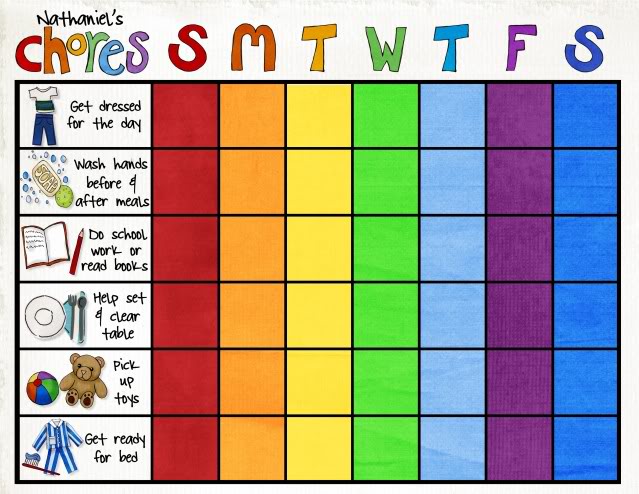Reward systems can be useful to children of all ages. Whether it’s to keep track of chores or to promote a certain behavior, reward systems can help children and parents to be more consistent. Reward systems teach children to “earn” privileges, but in order to work they should be age appropriate, and the rewards have to be something they want and are willing to work for. Here are a few suggestions:
Toddlers & Preschoolers – Simple sticker charts are easy for toddlers and preschoolers to understand. Display the chart in high traffic areas like the kitchen. Young children are very proud of their accomplishments; when charts are displayed in prominent areas it provides more opportunities to comment about their progress..Stock up on stickers they will like (look for sales at your local craft store chains). Work on one behavior at a time, such as picking up toys, putting dirty clothes in the hamper, or brushing their teeth. Put a sticker on the chart immediately after you see the desired behavior and praise the behavior as well. This creates positive reinforcement for good behavior.
School Age Children – School age children are probably used to some kind of chart system used in their classroom so they can handle a more complex system. Simple stickers may not be enough of an incentive for them. The stickers have to mean something. Rewards don’t have to cost a lot. Tell your child that after they get 3 stickers, or 5, (or whatever you decide) they will get to do something they like such as going to the park, making cookies with you etc. Children at this age can delay gratification for a little while, but make sure they can earn rewards on a regular basis, every few days or weekly. Also get their input on what they would like for a reward. You can work on 3 to 5 jobs or behaviors at a time, for example, making their bed, getting their school clothes and backpack ready the night before, setting the table, feeding the dog, etc.
Tweens – Tweens will be interested in more complicated systems with bigger rewards, but remember rewards don’t have to cost anything. They also don’t have to be something extra your child earns. You can use privileges for a reward. Instead of taking away privileges for misbehavior, you can allow your child to earn more TV time, more time on the computer, phone, or playing video games. Tweens probably think they are too old for stickers and charts on the refrigerator, but they can earn check marks or tokens and turn them in for rewards. For instance, 4 check marks could equal one hour of playing video games, or 2 tokens could equal 30 minutes of TV time. You can pick 3 to 5 behaviors or jobs to work on at a time. Pick at least one behavior that the child does fairly well already so he /she will feel successful and motivated to use the new system.
Teenagers – Teen agers know everything! Consequently they will certainly feel they have outgrown charts, stickers, or any other kind of reward system. However, this doesn’t mean you have to get rid of reward systems altogether. Instead, you can draw up a behavior contract linking privileges to certain behavior. For example, if they want to spend hassle free time with their friends on the weekends, all homework for the week has to be handed in on time. In order to keep their cell phone for the week their room has to be cleaned and laundry has to be done once a week, or give them their cell phone only after their previous day’s chores have been completed. If they don’t sweep the kitchen floor & take out the trash they do’t get their phone the next day. Just establish clear simple rules and make sure they understand what is expected of them. Actions speak louder than words, just refer to the contract and let them know they didn’t keep their end of the bargain. Don’t argue with them, the consequences are already spelled out in the contract.
AsheBridge Children’s Academy offers quality preschool education for our communities in Apex, Cary, Fuquay, Holly Springs, Angier, and surrounding areas. Contact us today to learn about all the fun things that set us apart from the other daycare and childcare centers.

